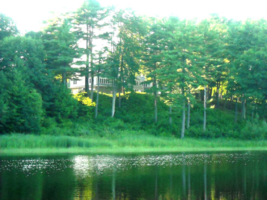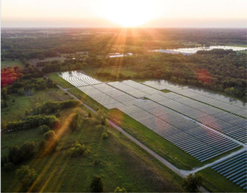August 2021
In this Issue:

By Colin Clark
A change in state statute was made in 2019 relating to Shoreland Ordinances and now requires municipal ordinances regulating the shoreland zone to adopt language requiring applicants developing within the shoreland zone to provide preconstruction and post construction photos of the shoreline vegetation and the developed site as part of the permitting process. The additional submission of the preconstruction photos will give property owners and municipal officials an established baseline and the post construction photos will document the conditions after construction. The addition of this photo requirement should provide a benefit to property owners and municipal officials in achieving desired compliance, as well as give the permitting body a better understanding of the preconstruction site conditions.
The specific language from Statute is as follows:
38 M.R.S. § 439-A(10) Photographic record required. A municipal ordinance adopted pursuant to this article must require an applicant for a permit for development within the shoreland zone to provide to the municipal permitting authority preconstruction photographs and, no later than 20 days after completion of the development, postconstruction photographs of the shoreline vegetation and development site.
When updating their ordinances, municipalities must include language consistent with this legal requirement. Please contact us if you need assistance.
|

By Dawn Hurd
With the increased interest in solar energy, the Department has been responding to questions about the development of commercial solar energy projects and how those are regulated under shoreland zoning.
A question that comes up often is whether commercial solar projects are classified as an Essential Service or a Commercial Use in terms of the Table of Land Uses in the Shoreland Zone?
The transmission and distribution of electricity falls within the definition of essential services, but power plants and other commercial generators of power, including wind power and solar projects do not. Commercial solar projects are a commercial use, fitting with in the definition of “commercial use” – “the use of lands, buildings, or structures, other than a ‘home occupation,’ the intent and result of which activity is the production of income from the buying and selling of goods and/or services.” (Ch. 1000, § 17 Definitions.)
Another question is in which districts these commercial solar projects are allowed? Commercial solar projects are permitted in Limited Commercial and General Development districts, but are not allowed in Resource Protection, Stream Protection, and Limited Residential districts. This is the same as for other commercial uses.
|
By Colin Clark
Over the past year, it has come to our attention that multiple municipal variance applications were never submitted to the Department for review. In some instances, local boards may have approved variances in violation of State law and could have benefited from Department comments, and in others, not submitting a copy of the variance request delayed local decisions. As a reminder, State law requires municipalities to forward applications for variances from dimensional standards involving shoreland property to the Department of Environmental Protection at least 20 days prior to the local Board of Appeals taking action on the application. Under Title 38 MRS, Section 438-A(6), “the material submitted shall include the application plus the supporting information provided by the applicant.” The application should include space for the appellant to provide documentation for the undue hardship criteria. These criteria are defined under Title 30 MRS, Section 4961-A(2)(C). The applicant has the burden of proof to show that their situation represents an undue hardship as defined by State law.
After submission to the Department, the Commissioner, typically through staff, then has 20 days to comment on whether the submitted information supports the undue hardship criteria. These comments become part of the record for the Board of Appeals to use in making its decision. The comments should not be used to substitute for the local Board of Appeals’ findings of fact. The Commissioner does not make the decision for the local board of appeals but rather offers perspective on how an individual variance should be handled locally, informed by input from the Office of the Attorney General when needed.
As part of our Covid-19 response, variance applications and their corresponding materials should be submitted electronically to the following email addresses:
Northern and Eastern Maine locations
Dawn.M.Hurd@maine.gov
Central Maine locations
Colin.A.Clark@maine.gov
Southern Maine locations
Jeffrey.C.Kalinich@maine.gov
By Jeff Kalanich
In 2015, the amendments to Chapter 1000 included adding language regarding the footprint of a structure and removed language regarding a structure’s area and volume for proposed expansions of non-conforming structures. While Towns were not required to adopt the 2015 amendments by a set date, the Mandatory Shoreland Zoning Act (Act), Sec. 439-A(4), states in part that “notwithstanding any provision in a local ordinance to the contrary” Towns must follow the footprint standards in the Act, which are the standards in the current version of Chapter 1000. After consultation with the Attorney General’s Office, the Department has determined that towns that have not adopt the 2015 footprint standards, and still use the area and volume standards from the 2006 version of Chapter 1000, must review a project under both the individual town’s ordinance and existing State law (which is the same as the current version of Chapter 1000) and apply the more restrictive standard to the project. For simplicity and clarity, the Department recommends adoption of the 2015 footprint standards. If you have questions or would like assistance adopting the footprint and other 2015 amendments contact your regional shoreland zoning coordinator.
By Tom Gilbert, Maine Forest Service
Timber harvesting standards in shoreland areas vary by location in the State. Most organized towns have adopted Chapter 21 rules, also known as “Statewide Standards” into their shoreland ordinances. These towns receive assistance from the Maine Forest Service (MFS) for timber harvesting related issues in shoreland areas. Other municipalities, who have chosen to adopt their own standards for timber harvesting in shoreland areas, must administer and regulate those standards without assistance from MFS in many cases. Finally, there are Chapter 27 rules for timber harvesting in shoreland areas in unorganized territories.
What are Statewide Standards?
Statewide Standards for Timber Harvesting and Related Activities in Shoreland Areas apply to water bodies and wetlands in many organized towns. These towns have given enforcement responsibility in part or entirely to the Maine Forest Service. For an up to date list of towns where Statewide Standards apply see:
https://www.maine.gov/dacf/mfs/rules_regs/docs/sws_town_status_list.pdf
Where do Statewide Standards apply?
Statewide Standards for timber harvesting and related activities apply to the following areas:
Within 250 feet of
- Great Ponds (waterbodies larger than 10 acres);
- Rivers (downstream of the point where the watershed drains 25 square miles);
- Tidal waters and coastal wetlands;
- Non-forested freshwater wetlands larger than 10 acres;
- Any size pond or freshwater wetland identified by the Department of Inland Fisheries and Wildlife as significant wildlife habitat or essential wildlife habitat
Within 75 feet of
- Streams, downstream of the point where the watershed drains 300 acres
Adjacent to
- Streams above the 300-acre drainage point;
- Ponds or freshwater wetlands larger than 4,300 square feet but less than 10 acres that that are not identified by the Department of Inland Fisheries and Wildlife as significant wildlife habitat or essential wildlife habitat.
The Maine Forest Service is available to assist towns who are interested in adopting Statewide Standards into their municipal shoreland zoning ordinances. For more information on adopting Statewide Standards and receiving greater assistance on enforcement of timber harvesting standards in shoreland areas, please contact Tom Gilbert at 441-5282 or at thomas.gilbert@maine.gov. For more information on Statewide Standards and a list of towns that have adopted Statewide Standards please visit the Maine Forest Service website at: https://www.maine.gov/dacf/mfs/policy_management/water_resources/sws/sws.html.
|